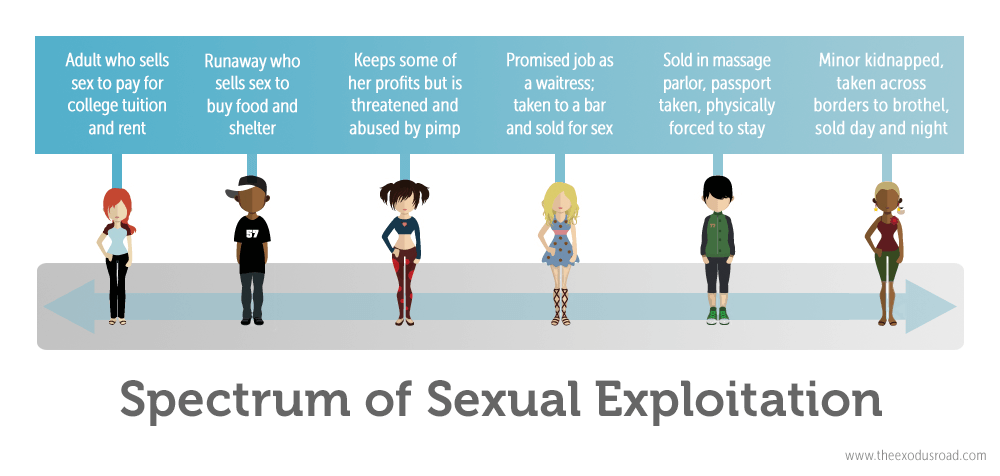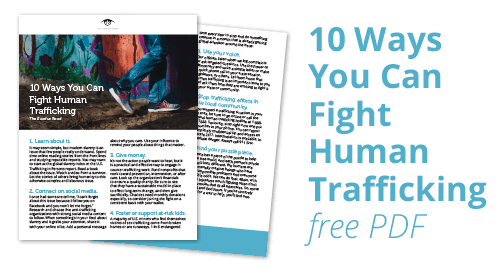Is that sex worker a “prostitute” or a victim of human trafficking?
It’s complicated. But you can know one thing for sure: She is exploited.
Poi is 24. Born in a poor, rural village in Thailand, she was married at 17 and has five children. After her husband left their family, it was up to Poi to provide for herself and her children. Without an education or job opportunities, Poi reluctantly goes into the city and starts to prostitute at a bar. She sends the small amount she receives to her children. It isn’t the life she would choose for herself, but she doesn’t see another way.
Kaya is 15. Also poor and uneducated, she wants to help her family survive after a bad crop leaves them in terrible debt. A man from her village says he can get her a job as a maid in the nearby city. She gets in a taxi, is transported across borders to a country where she doesn’t speak the language, and is then sold into a brothel where she is forced to have sex with 10-15 men every night. Her virginity is sold for $20. She has no money and no passport to get back home.
Poi and Kaya are both affected by poverty and social exploitation. Both have been given few choices and opportunities in life. But Poi is a willing participant in the sex industry and Kaya is a victim of human trafficking.* They both need help finding their way out, and they both need compassion. But their situation is not the same.
If the sex industry were a continuum, on one side are adult men and women who are knowing and willing participants in prostitution. Whether through direct exploitation, because of poverty or abuse, or by choice, they use prostitution as a means for income. On the other end of the spectrum are human trafficking victims — those forced into the sex industry against their will by some measure of force, fraud, or coercion. And then, there’s a broad expanse of gray where the line between choice and force, between the sex industry and human trafficking, is indistinguishable.

Elements of Sex Trafficking1
Act: Recruitment, transportation, transfer, harboring or receipt of persons;
Means: Threat or use of force, coercion, abduction, fraud, deception, abuse of power or vulnerability, or giving payments or benefits to a person in control of the victim;
Purpose: Prostitution of others, sexual exploitation, forced labor or services, or slavery.
Elements of Prostitution2
Act: Sexual act or contact with another person in return for giving or receiving a fee or a thing of value;
Means: To invite, entice, offer, persuade, or agree to engage in prostitution.
The Differences
Human Trafficking
In recent years, human trafficking has become a more common topic, from presidential councils to celebrities drawing red Xs on their hands one day each year.
Accurate estimates on the number of people enslaved today are nearly impossible because of the hidden nature of the crime. Some estimate the global number to be near 50 million,3 while 20.9 million people are estimated to be in sexual slavery alone.4
But whatever the exact numbers are, it is true that at this moment there are people who are physically locked behind closed doors, who are threatened with their family’s safety, and who are paying off debts by servicing men in brothels or working without pay.
Human trafficking forcefully converts a human being to a commodity. One person profits by stripping rights and dignity from another person. There is no element of choice for the trafficked person; he or she is a product in a multi-billion dollar industry.
Willing Participants in Prostitution
Prostitution is another oftentimes difficult reality for millions globally. Many women, particularly those living in impoverished areas, turn to prostitution because there are very little economic opportunities elsewhere. An uneducated woman can make fast money, she is under pressure to provide for her family, and she lives within widespread cultural acceptance of the sex industry. Prostitution quickly becomes a viable option — sometimes seemingly the only one.
One study of prostituted women in nine countries found that 70-95 percent of the women were physically assaulted, 60-75 percent were raped, and 89 percent of the women told researchers that they urgently wanted to escape prostitution.5 Even if individuals choose this profession, globally it’s a dangerous one full of exploitive and demeaning circumstances.
The Gray Area in Between
This conversation is not one or the other, however. Along the continuum of sexual exploitation, there are individuals who choose prostitution as a means of income, but are controlled and threatened by a pimp. There are minors who sell themselves by choice but are technically classified as human trafficking victims because of their age. And there are others who on the outside appear to be “willing prostitutes” but who are actually paying off a debt to the brothel — sometimes understanding and even agreeing to the debt repayment structure.
Labels in these scenarios are nothing less than complicated and oftentimes vary according to the local law. It’s important to understand that while sexual exploitation plays a role in each phase along the continuum, it does show up in different degrees.
Commercial sexual exploitation needs to be stopped. To affect change, we need to respond to the specific needs of both people caught in prostitution (even by choice) and people who are victims of human trafficking– and all those in between. But different problems need different solutions.
Our Response
The Exodus Road does not fight prostitution; we fight human trafficking. On the Sexual Exploitation continuum above, we focus on those on the far right side of the line. We focus on intervention, which means that we find and free victims of human trafficking alongside local authorities. We use advanced technology to build cases, we have investigators in brothels and bars, and we conduct rescue missions.
Every number we report as a “rescue” is an individual who was by definition a victim of human trafficking, and is now brought to safety. We help arrest traffickers and our social workers help survivors transition to freedom.
Our teams are not looking for women and men who are willingly staying in prostitution, but rather those who cannot walk away from their situations and who are classified under the law as actual “human trafficking victims.” We believe this laser focus of activity has strategic impact on the larger criminal systems of global human trafficking.
The world needs quality, committed people and organizations reaching out to those working in the sex industry — no matter where they fall in the spectrum of exploitation.
At The Exodus Road, we are committed to helping police find and free true victims of human trafficking.

Footnotes
*Prostitution and human trafficking laws vary among different countries, and there are nuances to these distinctions. For example, minors are considered human trafficking victims even if they willingly participate in prostitution. In some places all individuals in prostitution are considered sex trafficking victims, regardless of how they got there or if they “chose” it. While we speak from our experience in the United States and the countries where we work, we understand that this conversation is a complicated one.
1From the 2000 UN Protocol to Prevent, Suppress and Punish Trafficking in Persons, Especially Women and Children, ratified by 154 countries.
2From the 2014 U.S. Department of Justice Model State Provisions on Pimping, Pandering, and Prostitution.
3From the 2016 Global Slavery Index Report.
4From International Labour Organization, ILO global estimate of forced labour: results and methodology (2012) p. 13.
5From Farley, Melissa et al. “Prostitution and Trafficking in Nine Countries: An Update on Violence and Posttraumatic Stress Disorder.” Journal of Trauma Practice, Vol. 2, No. 3/4: 33-74, 2003.





